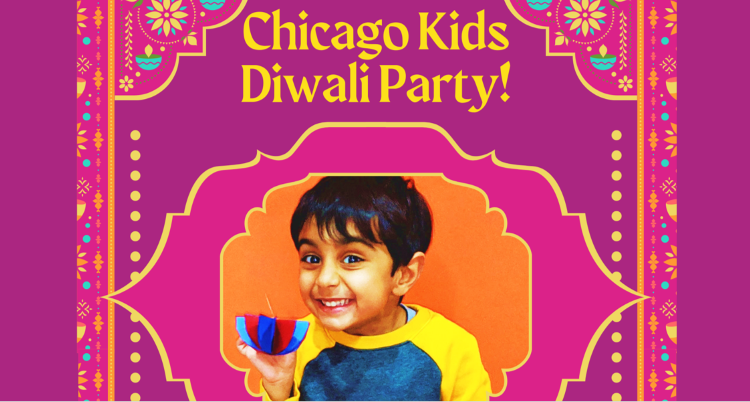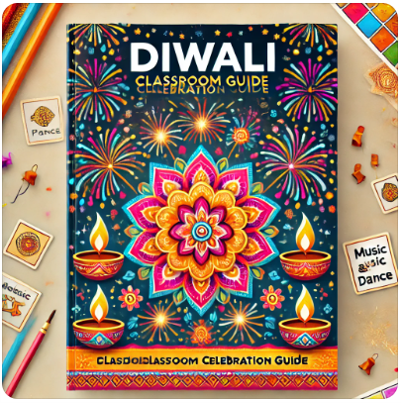Culture Connect Digest – The Great Wall of India
Nestled in the heart of Rajasthan, Kumbhalgarh Fort is a 15th-century architectural marvel often referred to as the “Great Wall of India.” With its awe-inspiring scale, intricate design, and fascinating history, this UNESCO World Heritage Site is a must-visit for history buffs, architecture enthusiasts, and curious travelers alike. Here are some incredible facts about this iconic fort that will leave you in awe:
1. Second Longest Wall in the World
Did you know that Kumbhalgarh Fort boasts the second-longest wall in the world, after the Great Wall of China? Stretching an impressive 36 kilometers (22 miles), the fort’s wall offers panoramic views of the surrounding Aravalli Hills and stands as a testament to the engineering brilliance of its time.
2. A Hidden Marvel
The fort’s design is nothing short of ingenious. Its walls and structures are so well integrated with the natural landscape that the fort is almost invisible from a distance. This clever camouflage helped it remain well-protected from enemies for centuries.
3. Secret Escapes and Hidden Features
Kumbhalgarh is filled with mysteries and secrets! The fort’s hidden tunnels, secret chambers, underground water reservoirs, and winding passages were designed to ensure the safety of its residents during sieges. Exploring these features feels like stepping into an ancient adventure story.
4. A Battle-Proof Fort
This fort is a masterpiece of defensive architecture. Its strategic design made it virtually impossible to conquer in battle. The only time it fell to an enemy was when invaders managed to poison the water supply – a rare and underhanded tactic.
5. A Temple Haven
Inside the fort, you’ll find an astonishing 360 temples, most of which are Jain temples. These structures showcase intricate carvings and architectural brilliance, making them a haven for those interested in history and spirituality.
6. Wide Enough for 8 Horses
The wall of Kumbhalgarh Fort isn’t just long; it’s also remarkably wide! At 15 feet, it’s spacious enough for eight horses to ride side by side. Today, you could even drive a car on it if permitted—a true testament to the grandeur of its construction.
So next time you’re in Rajasthan, make sure to add Kumbhalgarh Fort to your itinerary. It’s a destination that promises wonder, mystery, and a glimpse of India’s incredible history!
International Impact Book Award Winner!
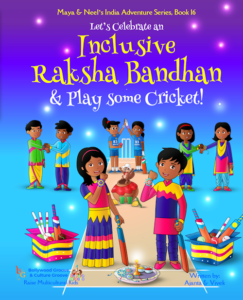
We are beyond thrilled and deeply grateful to share that the Maya & Neel India Adventure Series has been honored with the International Impact Book Awards! 🎉✨
This recognition feels especially meaningful as it celebrates our latest book, which reimagines a traditional festival in a modern, inclusive light. ❤️🌍
We poured our hearts into creating a story that breaks stereotypes and opens up the joy of Raksha Bandhan to everyone—regardless of gender or role. Knowing that this message is resonating globally validates our mission in the most incredible way. 🙏✨
Thank you to all our readers, supporters, and the amazing community that inspires us to keep sharing these stories. Here’s to making every tradition more inclusive and every story more meaningful! 🧡📚
#InclusiveBooks #GlobalImpact #RakshaBandhanForAll #Mayaneelbooks
Kids Classes are BACK with a Brand New Format!
BollyGroove Kids Classes are BACK with a brand new format!
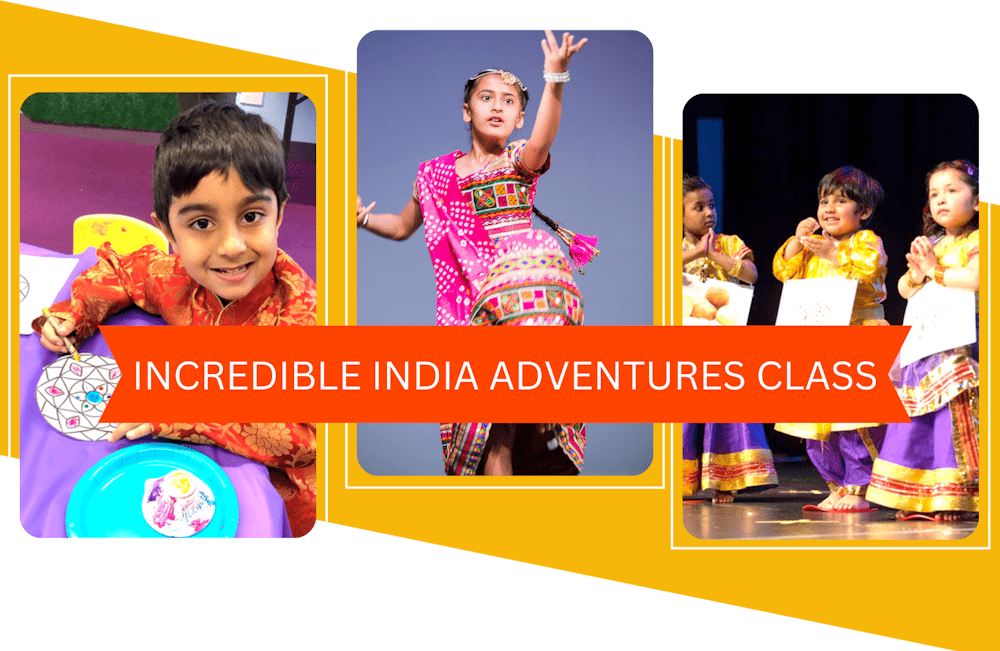
A Unique Immersive Class for Chicago Kids!
Incredible India Adventures – Journey beyond Dance in this immersive cultural adventure! Kids will explore the vibrant world of India through captivating Dance, colorful folk Art, conversational Hindi, mindful Yoga, vibrant Festivals, incredible Architecture, and delicious Food.
This isn’t just another Bollywood dance class—it’s an immersive cultural experience where every child becomes a world traveler, learning about India’s rich traditions and diverse landscapes while having fun!
Locations: West Loop & Lakeview, Chicago
Get notified when registration opens:
2024 Chicago Kids Diwali Party!
Join Bubbles Academy AND Bollywood & Culture Groove for another year of the Ultimate Kids Diwali party!
Diwali is the festival of lights and is the most popular festival in India.
Location: Bubbles Academy, 2184 N Elston Ave, Chicago
Date/Time: Sat, Nov 2, 4 pm to 6 pm
Join us for an afternoon of fun and excitement including:
* Diwali Storytime
* Make a cool Diwali Craft
* Diwali Dance Party!
Tickets are $30 per child.

10 ways to celebrate Diwali at Schools
It’s Diwali and you plan to do *something* around the festival at your kids’ school. Or maybe you are a teacher who wants to create a more multicultural and inclusive environment in their classroom. Here are some easy ways to provide a memorable cultural experience!
1. Introduce the meaning and 5 Days of Diwali
Explain the significance of Diwali, the Festival of Lights, and its themes of good triumphing over evil, light over darkness, and knowledge over ignorance. Talk about the 5 days of Diwali with celebrations that are more cultural than religious.
Use the slide from our free Diwali Celebration guide!
What’s included? everything mentioned on this page along with 45, 60, and 5-day lesson plans along with a Diwali dessert recipe.
2. Storytime with Diwali Tales
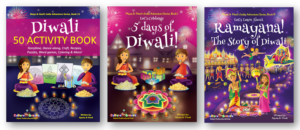
Books are a fantastic way to get the celebration going!
Share age-appropriate stories from Diwali such as 5 days of Diwali, what are they called and how do you celebrate each day. Check out Maya/Neel’s three Bestselling Diwali books!
3. Make a fun and simple Diwali craft
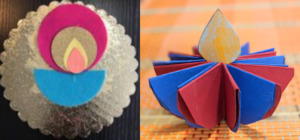
Nothing better than a hands-on activity! I love this one because of how easy it is to both arrange for the material and also for kids of all ages to do.
4. Screen a Kid-Friendly Diwali Video
Show an educational and engaging video about Diwali to help children better understand the holiday, its traditions, and how it is celebrated.
5. Invite a Guest Speaker/Author/Dance Instructor

If possible, bring in a guest speaker from the community, like a parent, author or cultural educator, to speak about their Diwali traditions and answer children’s questions.
An Indian dance workshop is another way to provide a fun and hands-on cultural experience!
Ajanta provides incredibly fun Diwali interactive experiences at schools, libraries, and corporates.
6. Host a Diwali Quiz

Use this template to host a fun Diwali quiz! Offer small rewards for participation to make learning fun and interactive.
7. Talk about Diwali Day of Giving
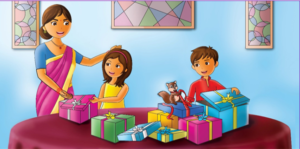
As we mention in our books, Day 4 of Diwali is also celebrated as Saal Mubarak, when people often exchange new year gifts.
Taking this to one step further into giving to the ones in need, we have set up a Diwali Day of Kindness.
How do you participate? Simply enter any acts of kindness performed between now and 4th day of Diwali here.
8. Make a Diwali pop-up card

Make this super fun Diwali pop-up card! The kids love the 3D aspect of this activity.
9. Teach a fun Diwali song
Introduce children to a really fun Diwali song that teaches them about 5 Days of Diwali in the tune of 12 days of Christmas!
10. 5 Days of Diwali Coloring page
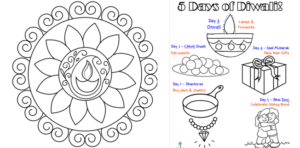
A Rangoli coloring page can be quite fun but even better is a coloring page that brings the learning of 5 Days of Diwali home!
Our free Diwali celebration guide has both. Please use whichever suits your needs best.



